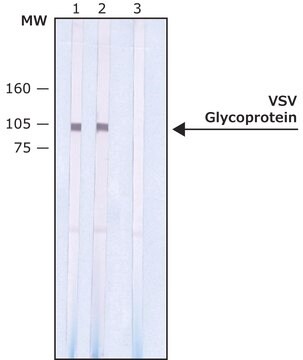A1970
Anti-VSV-Glycoprotein−Agarose antibody, Mouse monoclonal
clone P5D4, purified from hybridoma cell culture, PBS suspension
Sinonimo/i:
Monoclonal Anti-VSV Glycoprotein
About This Item
Prodotti consigliati
Origine biologica
mouse
Coniugato
agarose conjugate
Forma dell’anticorpo
purified immunoglobulin
Tipo di anticorpo
primary antibodies
Clone
P5D4, monoclonal
Stato
PBS suspension
Classi chimiche degli analiti
proteins (VSV-G)
tecniche
immunoprecipitation (IP): suitable
protein purification: suitable
Isotipo
IgG1
Capacità
≥15 nmol/mL, resin binding capacity (VSV-G tagged fusion protein)
Condizioni di spedizione
wet ice
Temperatura di conservazione
2-8°C
Cerchi prodotti simili? Visita Guida al confronto tra prodotti
Descrizione generale
Specificità
Immunogeno
Applicazioni
Immunoprecipitation (1 paper)
Stato fisico
Nota sulla preparazione
Non trovi il prodotto giusto?
Prova il nostro Motore di ricerca dei prodotti.
Codice della classe di stoccaggio
10 - Combustible liquids
Classe di pericolosità dell'acqua (WGK)
nwg
Punto d’infiammabilità (°F)
Not applicable
Punto d’infiammabilità (°C)
Not applicable
Scegli una delle versioni più recenti:
Possiedi già questo prodotto?
I documenti relativi ai prodotti acquistati recentemente sono disponibili nell’Archivio dei documenti.
Il team dei nostri ricercatori vanta grande esperienza in tutte le aree della ricerca quali Life Science, scienza dei materiali, sintesi chimica, cromatografia, discipline analitiche, ecc..
Contatta l'Assistenza Tecnica.







